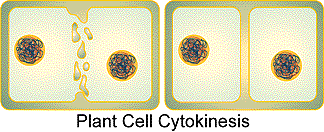
Read behavioral objective 13. Below is a sample question involving the objective.
35. Corn ( Zea maize) contains 20 chromosomes is its somatic cell. How
many chromatids would this
cell contain in its metaphase stage?
a) 2 b) 10
c) 20 d) 40
Press here to check answer. press
Read the pages indicated by G-7
and study behavioral
objective 14 and 15. After the completion of nuclear division (mitosis)
the cytoplasm will divide into almost equal halves in a manner that each
half will contain one of the nuclei. This event is called cytokinesis.
Because plant cells have a thick cell wall cytokinesis occurs differently
in plant cells than animal cells. In your notes write a description
contrasting between cytokinesis in plant cells and animal cells. Include
the following terms: cell plate,
ring of microfilaments, pinching.
k
Note how a cell wall forms between the two newly synthesized nuclei
in the plant cell above. The cell wall forms along a cell plate
which is formed by microtubules. The above figure shows the formation of
a cell plate after the two nuclei have reformed during late telophase in
a plant cell.
k
Note how the cell membrane simply pinches the cytoplasm
into two parts with a newly synthesized nucleus in each cell.
To move to the next page you must answer the following question correctly.
Why can't the plant cell's cytoplasm simply pinch into two parts?
a ) The stiff cell wall prevents it from
being pinched into two parts.
b ) Plant cells do not have Golgi to
form elastin used for stretching the cell membrane.
For information on how to use this page, go to How
to Use This Site.
Created by the Center for Learning Technologies, Academic Technology Services.
Last modified October 22, 1997.